Economics for Business: Supply-Side Policies and Economic Stimulus
VerifiedAdded on 2020/07/22
|15
|4123
|273
Report
AI Summary
This economics report examines the relationship between economic growth and supply-side policies, providing an in-depth analysis of how these policies can enhance market efficiency and increase productivity. It delves into the methods by which government authorities utilize fiscal and monetary policies to stimulate economic activity, including expansionary and contractionary strategies. The report specifically addresses the UK's approach to supply-side policies, detailing measures such as privatization, tax reductions, and labor market deregulation. Furthermore, it explores the impact of these policies on unemployment, investment, and overall economic competitiveness. The report also discusses the benefits of supply-side policies, such as reduced tax burdens, lower unemployment rates, and improved economic growth, alongside a discussion of fiscal and monetary policy instruments. The report concludes with a comprehensive overview of how the UK government employs these policies to foster economic development and stability.
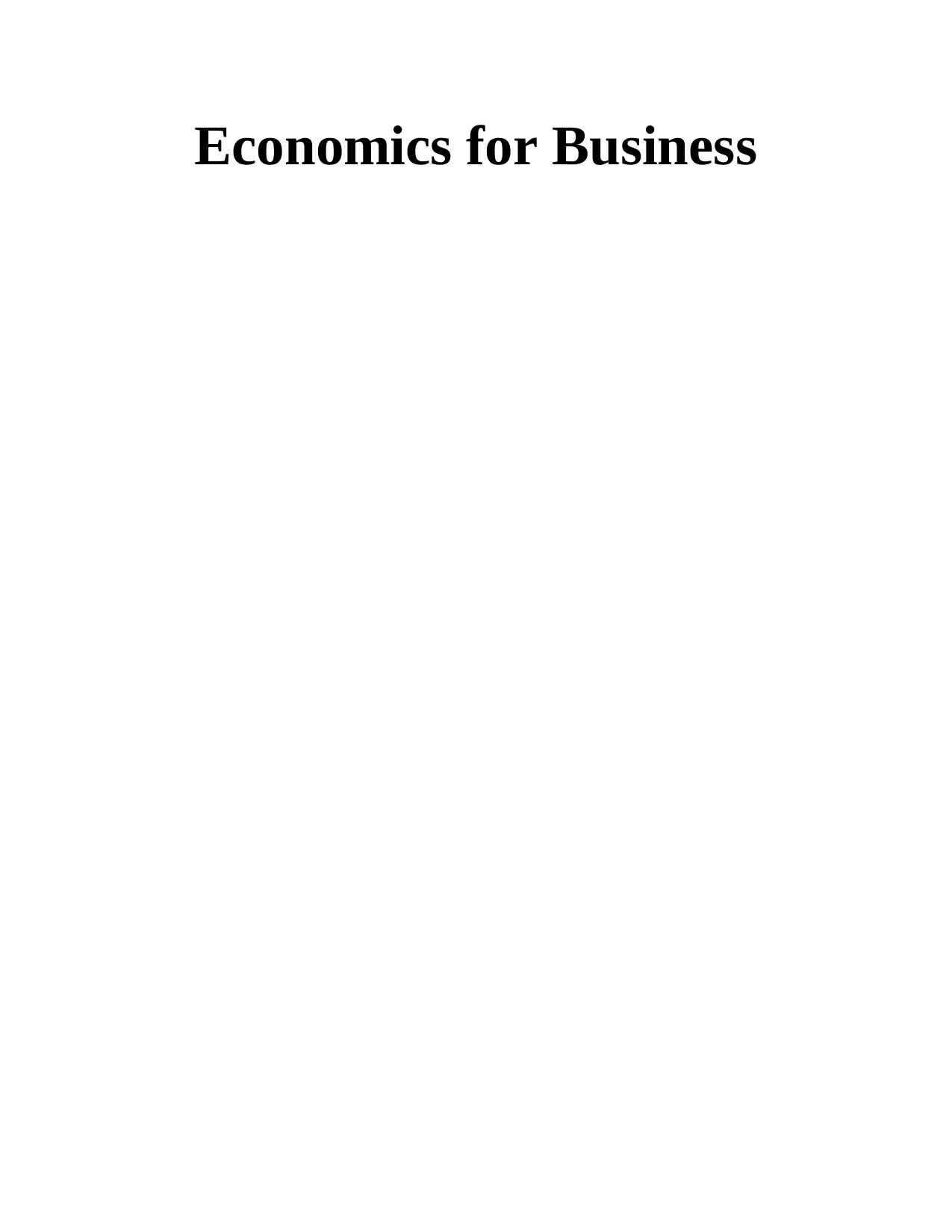
Economics for Business
Paraphrase This Document
Need a fresh take? Get an instant paraphrase of this document with our AI Paraphraser
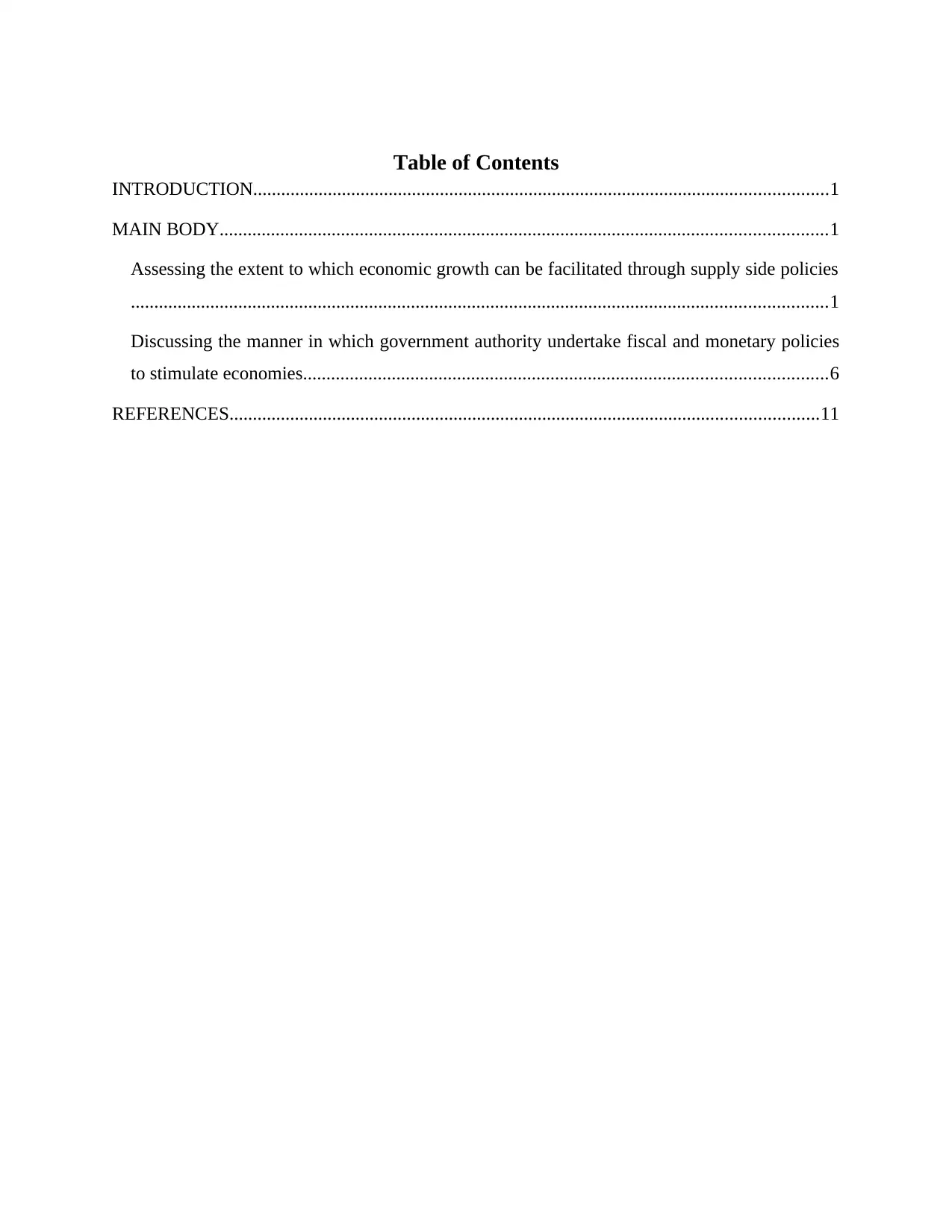
Table of Contents
INTRODUCTION...........................................................................................................................1
MAIN BODY..................................................................................................................................1
Assessing the extent to which economic growth can be facilitated through supply side policies
.....................................................................................................................................................1
Discussing the manner in which government authority undertake fiscal and monetary policies
to stimulate economies................................................................................................................6
REFERENCES..............................................................................................................................11
INTRODUCTION...........................................................................................................................1
MAIN BODY..................................................................................................................................1
Assessing the extent to which economic growth can be facilitated through supply side policies
.....................................................................................................................................................1
Discussing the manner in which government authority undertake fiscal and monetary policies
to stimulate economies................................................................................................................6
REFERENCES..............................................................................................................................11
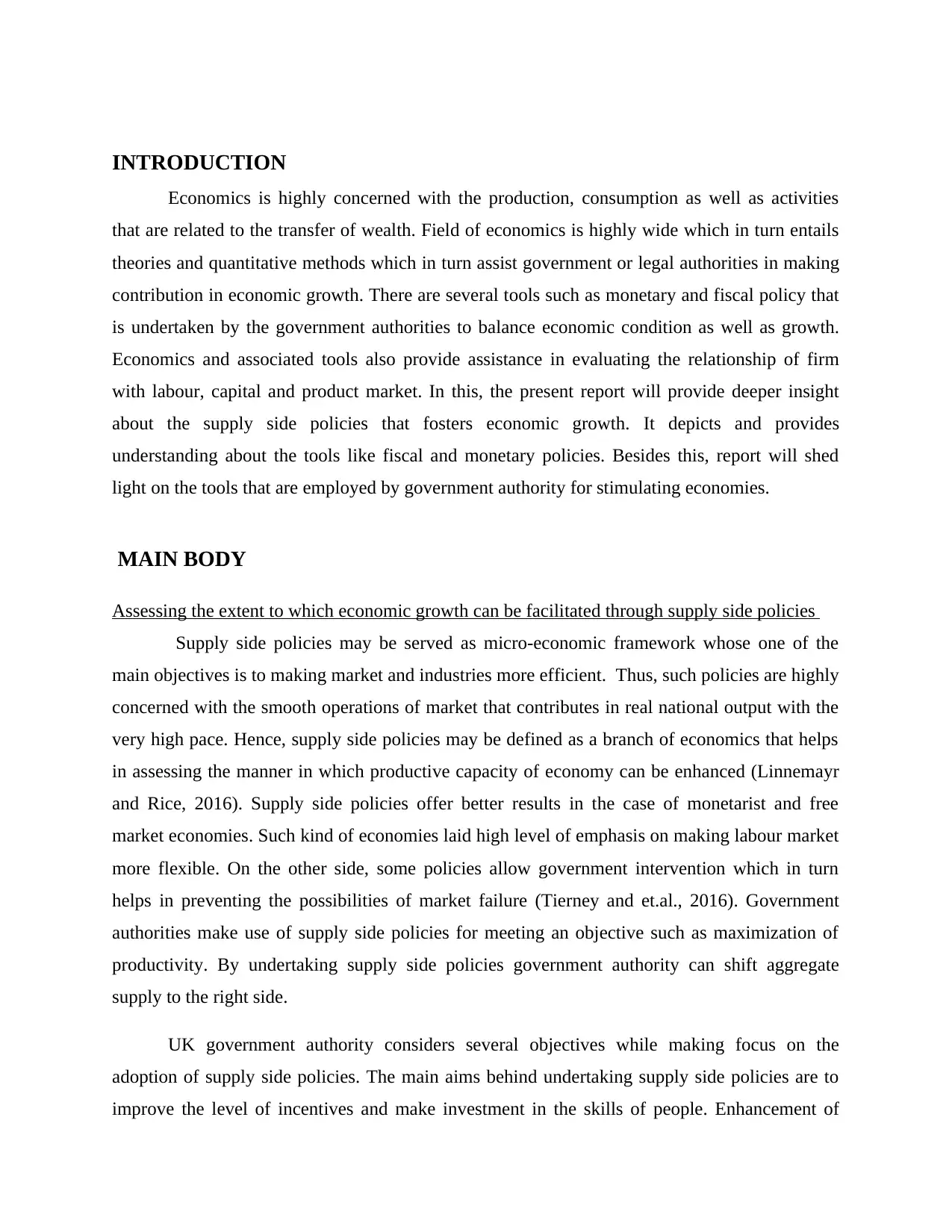
INTRODUCTION
Economics is highly concerned with the production, consumption as well as activities
that are related to the transfer of wealth. Field of economics is highly wide which in turn entails
theories and quantitative methods which in turn assist government or legal authorities in making
contribution in economic growth. There are several tools such as monetary and fiscal policy that
is undertaken by the government authorities to balance economic condition as well as growth.
Economics and associated tools also provide assistance in evaluating the relationship of firm
with labour, capital and product market. In this, the present report will provide deeper insight
about the supply side policies that fosters economic growth. It depicts and provides
understanding about the tools like fiscal and monetary policies. Besides this, report will shed
light on the tools that are employed by government authority for stimulating economies.
MAIN BODY
Assessing the extent to which economic growth can be facilitated through supply side policies
Supply side policies may be served as micro-economic framework whose one of the
main objectives is to making market and industries more efficient. Thus, such policies are highly
concerned with the smooth operations of market that contributes in real national output with the
very high pace. Hence, supply side policies may be defined as a branch of economics that helps
in assessing the manner in which productive capacity of economy can be enhanced (Linnemayr
and Rice, 2016). Supply side policies offer better results in the case of monetarist and free
market economies. Such kind of economies laid high level of emphasis on making labour market
more flexible. On the other side, some policies allow government intervention which in turn
helps in preventing the possibilities of market failure (Tierney and et.al., 2016). Government
authorities make use of supply side policies for meeting an objective such as maximization of
productivity. By undertaking supply side policies government authority can shift aggregate
supply to the right side.
UK government authority considers several objectives while making focus on the
adoption of supply side policies. The main aims behind undertaking supply side policies are to
improve the level of incentives and make investment in the skills of people. Enhancement of
Economics is highly concerned with the production, consumption as well as activities
that are related to the transfer of wealth. Field of economics is highly wide which in turn entails
theories and quantitative methods which in turn assist government or legal authorities in making
contribution in economic growth. There are several tools such as monetary and fiscal policy that
is undertaken by the government authorities to balance economic condition as well as growth.
Economics and associated tools also provide assistance in evaluating the relationship of firm
with labour, capital and product market. In this, the present report will provide deeper insight
about the supply side policies that fosters economic growth. It depicts and provides
understanding about the tools like fiscal and monetary policies. Besides this, report will shed
light on the tools that are employed by government authority for stimulating economies.
MAIN BODY
Assessing the extent to which economic growth can be facilitated through supply side policies
Supply side policies may be served as micro-economic framework whose one of the
main objectives is to making market and industries more efficient. Thus, such policies are highly
concerned with the smooth operations of market that contributes in real national output with the
very high pace. Hence, supply side policies may be defined as a branch of economics that helps
in assessing the manner in which productive capacity of economy can be enhanced (Linnemayr
and Rice, 2016). Supply side policies offer better results in the case of monetarist and free
market economies. Such kind of economies laid high level of emphasis on making labour market
more flexible. On the other side, some policies allow government intervention which in turn
helps in preventing the possibilities of market failure (Tierney and et.al., 2016). Government
authorities make use of supply side policies for meeting an objective such as maximization of
productivity. By undertaking supply side policies government authority can shift aggregate
supply to the right side.
UK government authority considers several objectives while making focus on the
adoption of supply side policies. The main aims behind undertaking supply side policies are to
improve the level of incentives and make investment in the skills of people. Enhancement of
⊘ This is a preview!⊘
Do you want full access?
Subscribe today to unlock all pages.

Trusted by 1+ million students worldwide
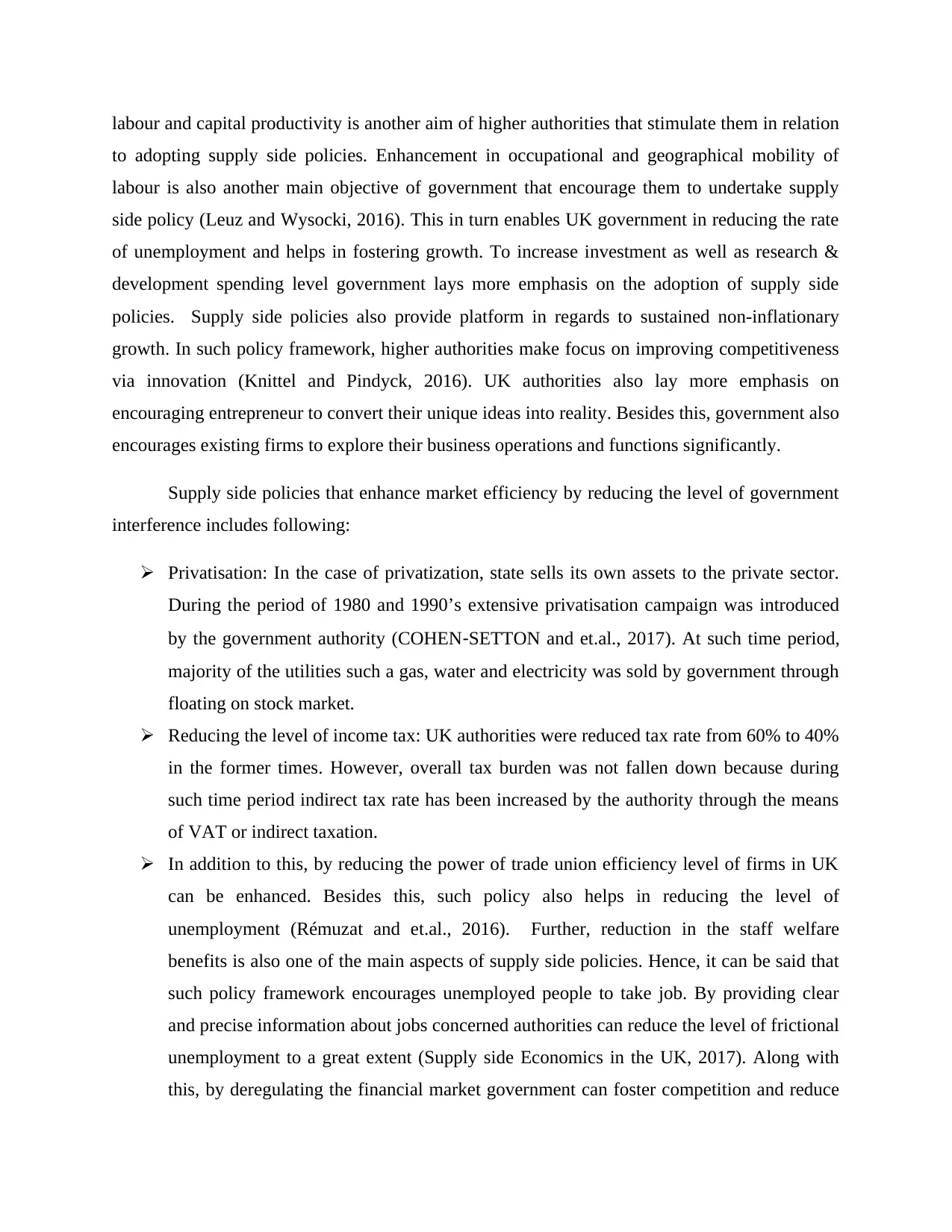
labour and capital productivity is another aim of higher authorities that stimulate them in relation
to adopting supply side policies. Enhancement in occupational and geographical mobility of
labour is also another main objective of government that encourage them to undertake supply
side policy (Leuz and Wysocki, 2016). This in turn enables UK government in reducing the rate
of unemployment and helps in fostering growth. To increase investment as well as research &
development spending level government lays more emphasis on the adoption of supply side
policies. Supply side policies also provide platform in regards to sustained non-inflationary
growth. In such policy framework, higher authorities make focus on improving competitiveness
via innovation (Knittel and Pindyck, 2016). UK authorities also lay more emphasis on
encouraging entrepreneur to convert their unique ideas into reality. Besides this, government also
encourages existing firms to explore their business operations and functions significantly.
Supply side policies that enhance market efficiency by reducing the level of government
interference includes following:
Privatisation: In the case of privatization, state sells its own assets to the private sector.
During the period of 1980 and 1990’s extensive privatisation campaign was introduced
by the government authority (COHEN‐SETTON and et.al., 2017). At such time period,
majority of the utilities such a gas, water and electricity was sold by government through
floating on stock market.
Reducing the level of income tax: UK authorities were reduced tax rate from 60% to 40%
in the former times. However, overall tax burden was not fallen down because during
such time period indirect tax rate has been increased by the authority through the means
of VAT or indirect taxation.
In addition to this, by reducing the power of trade union efficiency level of firms in UK
can be enhanced. Besides this, such policy also helps in reducing the level of
unemployment (Rémuzat and et.al., 2016). Further, reduction in the staff welfare
benefits is also one of the main aspects of supply side policies. Hence, it can be said that
such policy framework encourages unemployed people to take job. By providing clear
and precise information about jobs concerned authorities can reduce the level of frictional
unemployment to a great extent (Supply side Economics in the UK, 2017). Along with
this, by deregulating the financial market government can foster competition and reduce
to adopting supply side policies. Enhancement in occupational and geographical mobility of
labour is also another main objective of government that encourage them to undertake supply
side policy (Leuz and Wysocki, 2016). This in turn enables UK government in reducing the rate
of unemployment and helps in fostering growth. To increase investment as well as research &
development spending level government lays more emphasis on the adoption of supply side
policies. Supply side policies also provide platform in regards to sustained non-inflationary
growth. In such policy framework, higher authorities make focus on improving competitiveness
via innovation (Knittel and Pindyck, 2016). UK authorities also lay more emphasis on
encouraging entrepreneur to convert their unique ideas into reality. Besides this, government also
encourages existing firms to explore their business operations and functions significantly.
Supply side policies that enhance market efficiency by reducing the level of government
interference includes following:
Privatisation: In the case of privatization, state sells its own assets to the private sector.
During the period of 1980 and 1990’s extensive privatisation campaign was introduced
by the government authority (COHEN‐SETTON and et.al., 2017). At such time period,
majority of the utilities such a gas, water and electricity was sold by government through
floating on stock market.
Reducing the level of income tax: UK authorities were reduced tax rate from 60% to 40%
in the former times. However, overall tax burden was not fallen down because during
such time period indirect tax rate has been increased by the authority through the means
of VAT or indirect taxation.
In addition to this, by reducing the power of trade union efficiency level of firms in UK
can be enhanced. Besides this, such policy also helps in reducing the level of
unemployment (Rémuzat and et.al., 2016). Further, reduction in the staff welfare
benefits is also one of the main aspects of supply side policies. Hence, it can be said that
such policy framework encourages unemployed people to take job. By providing clear
and precise information about jobs concerned authorities can reduce the level of frictional
unemployment to a great extent (Supply side Economics in the UK, 2017). Along with
this, by deregulating the financial market government can foster competition and reduce
Paraphrase This Document
Need a fresh take? Get an instant paraphrase of this document with our AI Paraphraser
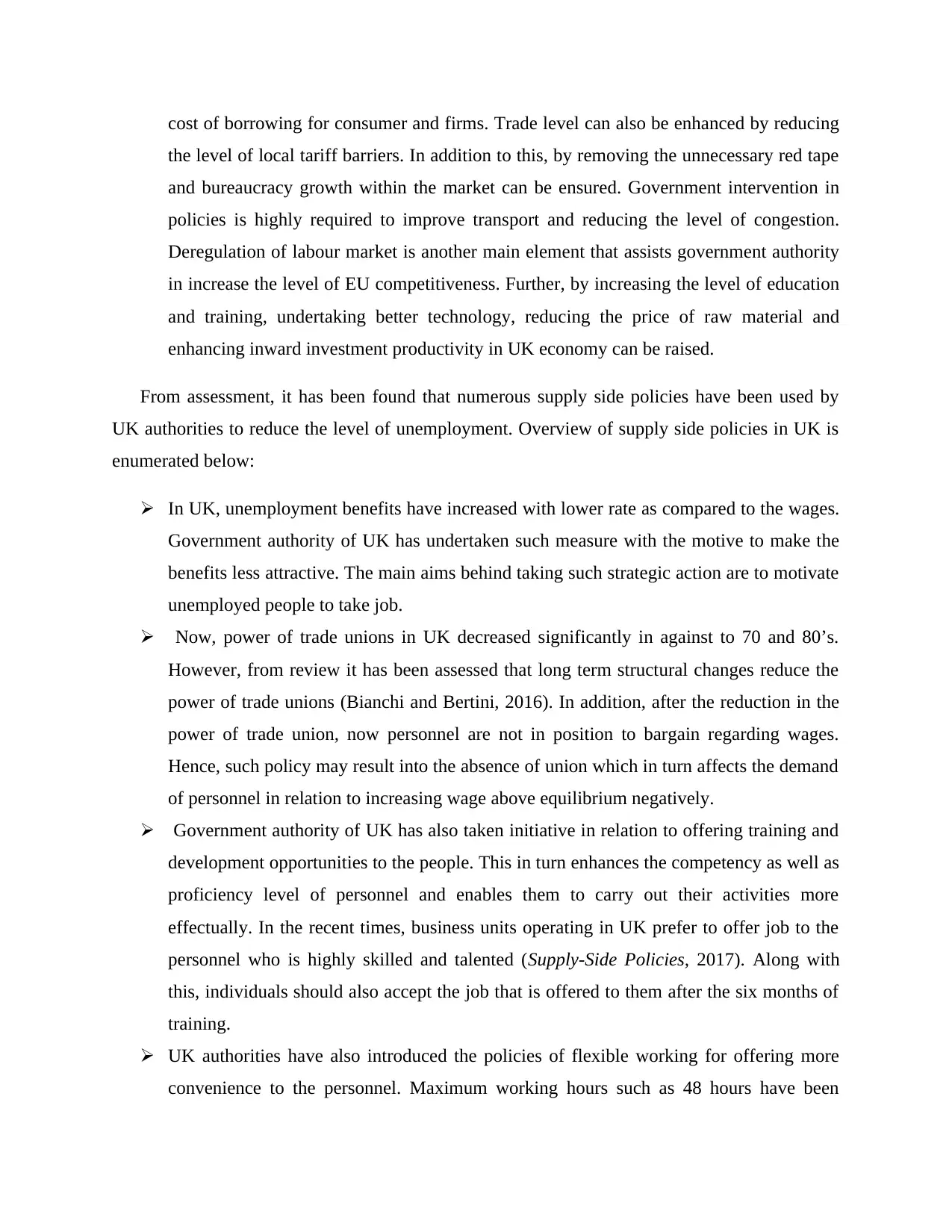
cost of borrowing for consumer and firms. Trade level can also be enhanced by reducing
the level of local tariff barriers. In addition to this, by removing the unnecessary red tape
and bureaucracy growth within the market can be ensured. Government intervention in
policies is highly required to improve transport and reducing the level of congestion.
Deregulation of labour market is another main element that assists government authority
in increase the level of EU competitiveness. Further, by increasing the level of education
and training, undertaking better technology, reducing the price of raw material and
enhancing inward investment productivity in UK economy can be raised.
From assessment, it has been found that numerous supply side policies have been used by
UK authorities to reduce the level of unemployment. Overview of supply side policies in UK is
enumerated below:
In UK, unemployment benefits have increased with lower rate as compared to the wages.
Government authority of UK has undertaken such measure with the motive to make the
benefits less attractive. The main aims behind taking such strategic action are to motivate
unemployed people to take job.
Now, power of trade unions in UK decreased significantly in against to 70 and 80’s.
However, from review it has been assessed that long term structural changes reduce the
power of trade unions (Bianchi and Bertini, 2016). In addition, after the reduction in the
power of trade union, now personnel are not in position to bargain regarding wages.
Hence, such policy may result into the absence of union which in turn affects the demand
of personnel in relation to increasing wage above equilibrium negatively.
Government authority of UK has also taken initiative in relation to offering training and
development opportunities to the people. This in turn enhances the competency as well as
proficiency level of personnel and enables them to carry out their activities more
effectually. In the recent times, business units operating in UK prefer to offer job to the
personnel who is highly skilled and talented (Supply-Side Policies, 2017). Along with
this, individuals should also accept the job that is offered to them after the six months of
training.
UK authorities have also introduced the policies of flexible working for offering more
convenience to the personnel. Maximum working hours such as 48 hours have been
the level of local tariff barriers. In addition to this, by removing the unnecessary red tape
and bureaucracy growth within the market can be ensured. Government intervention in
policies is highly required to improve transport and reducing the level of congestion.
Deregulation of labour market is another main element that assists government authority
in increase the level of EU competitiveness. Further, by increasing the level of education
and training, undertaking better technology, reducing the price of raw material and
enhancing inward investment productivity in UK economy can be raised.
From assessment, it has been found that numerous supply side policies have been used by
UK authorities to reduce the level of unemployment. Overview of supply side policies in UK is
enumerated below:
In UK, unemployment benefits have increased with lower rate as compared to the wages.
Government authority of UK has undertaken such measure with the motive to make the
benefits less attractive. The main aims behind taking such strategic action are to motivate
unemployed people to take job.
Now, power of trade unions in UK decreased significantly in against to 70 and 80’s.
However, from review it has been assessed that long term structural changes reduce the
power of trade unions (Bianchi and Bertini, 2016). In addition, after the reduction in the
power of trade union, now personnel are not in position to bargain regarding wages.
Hence, such policy may result into the absence of union which in turn affects the demand
of personnel in relation to increasing wage above equilibrium negatively.
Government authority of UK has also taken initiative in relation to offering training and
development opportunities to the people. This in turn enhances the competency as well as
proficiency level of personnel and enables them to carry out their activities more
effectually. In the recent times, business units operating in UK prefer to offer job to the
personnel who is highly skilled and talented (Supply-Side Policies, 2017). Along with
this, individuals should also accept the job that is offered to them after the six months of
training.
UK authorities have also introduced the policies of flexible working for offering more
convenience to the personnel. Maximum working hours such as 48 hours have been
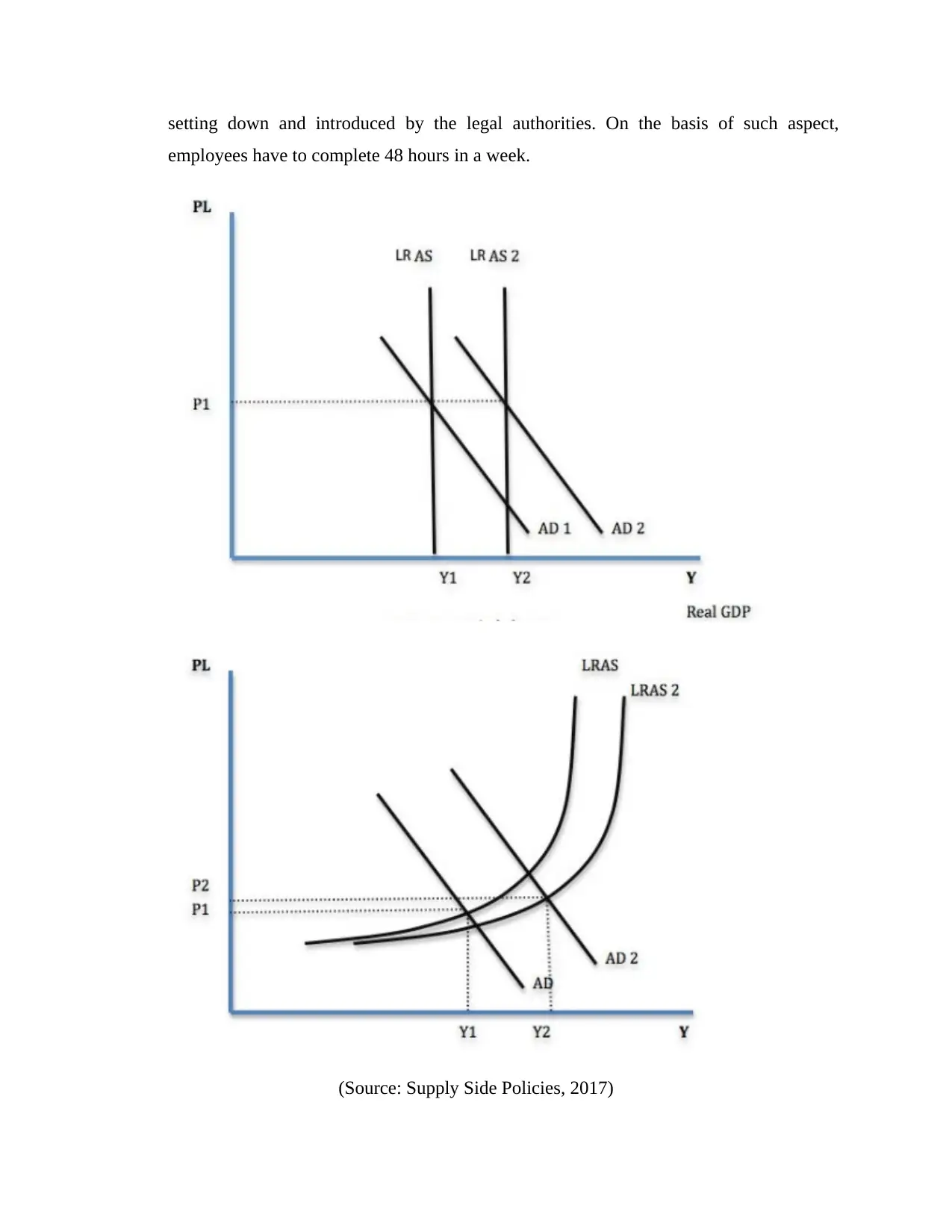
setting down and introduced by the legal authorities. On the basis of such aspect,
employees have to complete 48 hours in a week.
(Source: Supply Side Policies, 2017)
employees have to complete 48 hours in a week.
(Source: Supply Side Policies, 2017)
⊘ This is a preview!⊘
Do you want full access?
Subscribe today to unlock all pages.

Trusted by 1+ million students worldwide
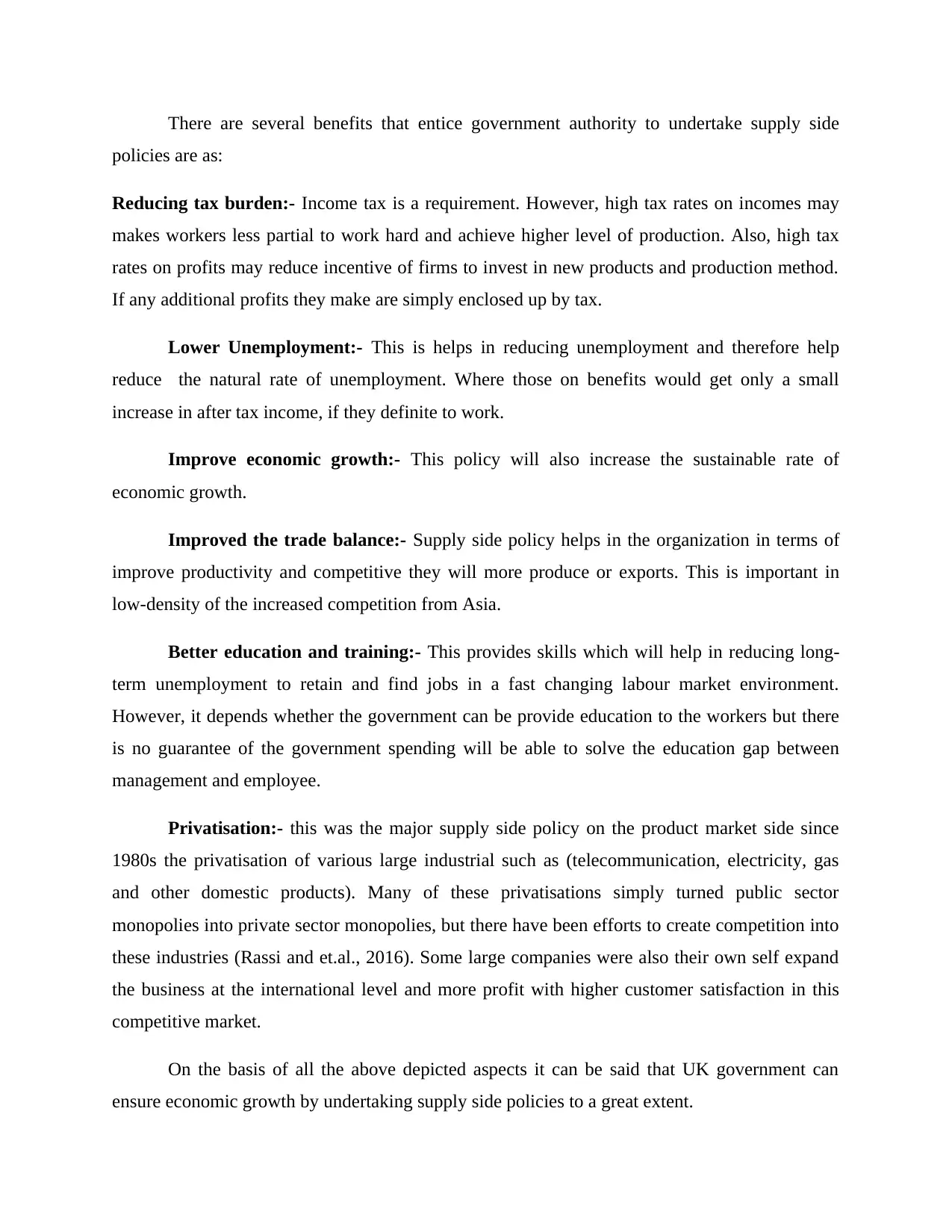
There are several benefits that entice government authority to undertake supply side
policies are as:
Reducing tax burden:- Income tax is a requirement. However, high tax rates on incomes may
makes workers less partial to work hard and achieve higher level of production. Also, high tax
rates on profits may reduce incentive of firms to invest in new products and production method.
If any additional profits they make are simply enclosed up by tax.
Lower Unemployment:- This is helps in reducing unemployment and therefore help
reduce the natural rate of unemployment. Where those on benefits would get only a small
increase in after tax income, if they definite to work.
Improve economic growth:- This policy will also increase the sustainable rate of
economic growth.
Improved the trade balance:- Supply side policy helps in the organization in terms of
improve productivity and competitive they will more produce or exports. This is important in
low-density of the increased competition from Asia.
Better education and training:- This provides skills which will help in reducing long-
term unemployment to retain and find jobs in a fast changing labour market environment.
However, it depends whether the government can be provide education to the workers but there
is no guarantee of the government spending will be able to solve the education gap between
management and employee.
Privatisation:- this was the major supply side policy on the product market side since
1980s the privatisation of various large industrial such as (telecommunication, electricity, gas
and other domestic products). Many of these privatisations simply turned public sector
monopolies into private sector monopolies, but there have been efforts to create competition into
these industries (Rassi and et.al., 2016). Some large companies were also their own self expand
the business at the international level and more profit with higher customer satisfaction in this
competitive market.
On the basis of all the above depicted aspects it can be said that UK government can
ensure economic growth by undertaking supply side policies to a great extent.
policies are as:
Reducing tax burden:- Income tax is a requirement. However, high tax rates on incomes may
makes workers less partial to work hard and achieve higher level of production. Also, high tax
rates on profits may reduce incentive of firms to invest in new products and production method.
If any additional profits they make are simply enclosed up by tax.
Lower Unemployment:- This is helps in reducing unemployment and therefore help
reduce the natural rate of unemployment. Where those on benefits would get only a small
increase in after tax income, if they definite to work.
Improve economic growth:- This policy will also increase the sustainable rate of
economic growth.
Improved the trade balance:- Supply side policy helps in the organization in terms of
improve productivity and competitive they will more produce or exports. This is important in
low-density of the increased competition from Asia.
Better education and training:- This provides skills which will help in reducing long-
term unemployment to retain and find jobs in a fast changing labour market environment.
However, it depends whether the government can be provide education to the workers but there
is no guarantee of the government spending will be able to solve the education gap between
management and employee.
Privatisation:- this was the major supply side policy on the product market side since
1980s the privatisation of various large industrial such as (telecommunication, electricity, gas
and other domestic products). Many of these privatisations simply turned public sector
monopolies into private sector monopolies, but there have been efforts to create competition into
these industries (Rassi and et.al., 2016). Some large companies were also their own self expand
the business at the international level and more profit with higher customer satisfaction in this
competitive market.
On the basis of all the above depicted aspects it can be said that UK government can
ensure economic growth by undertaking supply side policies to a great extent.
Paraphrase This Document
Need a fresh take? Get an instant paraphrase of this document with our AI Paraphraser
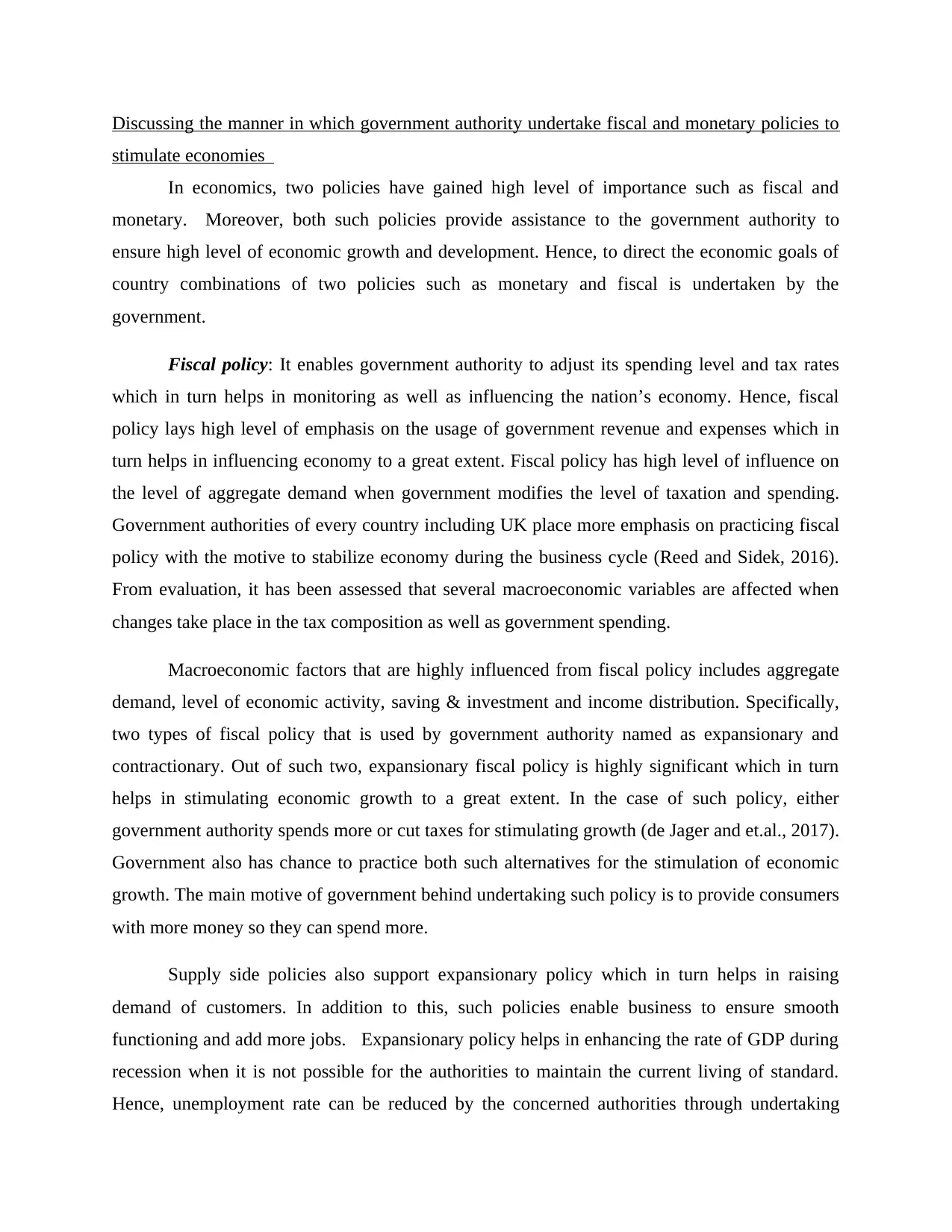
Discussing the manner in which government authority undertake fiscal and monetary policies to
stimulate economies
In economics, two policies have gained high level of importance such as fiscal and
monetary. Moreover, both such policies provide assistance to the government authority to
ensure high level of economic growth and development. Hence, to direct the economic goals of
country combinations of two policies such as monetary and fiscal is undertaken by the
government.
Fiscal policy: It enables government authority to adjust its spending level and tax rates
which in turn helps in monitoring as well as influencing the nation’s economy. Hence, fiscal
policy lays high level of emphasis on the usage of government revenue and expenses which in
turn helps in influencing economy to a great extent. Fiscal policy has high level of influence on
the level of aggregate demand when government modifies the level of taxation and spending.
Government authorities of every country including UK place more emphasis on practicing fiscal
policy with the motive to stabilize economy during the business cycle (Reed and Sidek, 2016).
From evaluation, it has been assessed that several macroeconomic variables are affected when
changes take place in the tax composition as well as government spending.
Macroeconomic factors that are highly influenced from fiscal policy includes aggregate
demand, level of economic activity, saving & investment and income distribution. Specifically,
two types of fiscal policy that is used by government authority named as expansionary and
contractionary. Out of such two, expansionary fiscal policy is highly significant which in turn
helps in stimulating economic growth to a great extent. In the case of such policy, either
government authority spends more or cut taxes for stimulating growth (de Jager and et.al., 2017).
Government also has chance to practice both such alternatives for the stimulation of economic
growth. The main motive of government behind undertaking such policy is to provide consumers
with more money so they can spend more.
Supply side policies also support expansionary policy which in turn helps in raising
demand of customers. In addition to this, such policies enable business to ensure smooth
functioning and add more jobs. Expansionary policy helps in enhancing the rate of GDP during
recession when it is not possible for the authorities to maintain the current living of standard.
Hence, unemployment rate can be reduced by the concerned authorities through undertaking
stimulate economies
In economics, two policies have gained high level of importance such as fiscal and
monetary. Moreover, both such policies provide assistance to the government authority to
ensure high level of economic growth and development. Hence, to direct the economic goals of
country combinations of two policies such as monetary and fiscal is undertaken by the
government.
Fiscal policy: It enables government authority to adjust its spending level and tax rates
which in turn helps in monitoring as well as influencing the nation’s economy. Hence, fiscal
policy lays high level of emphasis on the usage of government revenue and expenses which in
turn helps in influencing economy to a great extent. Fiscal policy has high level of influence on
the level of aggregate demand when government modifies the level of taxation and spending.
Government authorities of every country including UK place more emphasis on practicing fiscal
policy with the motive to stabilize economy during the business cycle (Reed and Sidek, 2016).
From evaluation, it has been assessed that several macroeconomic variables are affected when
changes take place in the tax composition as well as government spending.
Macroeconomic factors that are highly influenced from fiscal policy includes aggregate
demand, level of economic activity, saving & investment and income distribution. Specifically,
two types of fiscal policy that is used by government authority named as expansionary and
contractionary. Out of such two, expansionary fiscal policy is highly significant which in turn
helps in stimulating economic growth to a great extent. In the case of such policy, either
government authority spends more or cut taxes for stimulating growth (de Jager and et.al., 2017).
Government also has chance to practice both such alternatives for the stimulation of economic
growth. The main motive of government behind undertaking such policy is to provide consumers
with more money so they can spend more.
Supply side policies also support expansionary policy which in turn helps in raising
demand of customers. In addition to this, such policies enable business to ensure smooth
functioning and add more jobs. Expansionary policy helps in enhancing the rate of GDP during
recession when it is not possible for the authorities to maintain the current living of standard.
Hence, unemployment rate can be reduced by the concerned authorities through undertaking
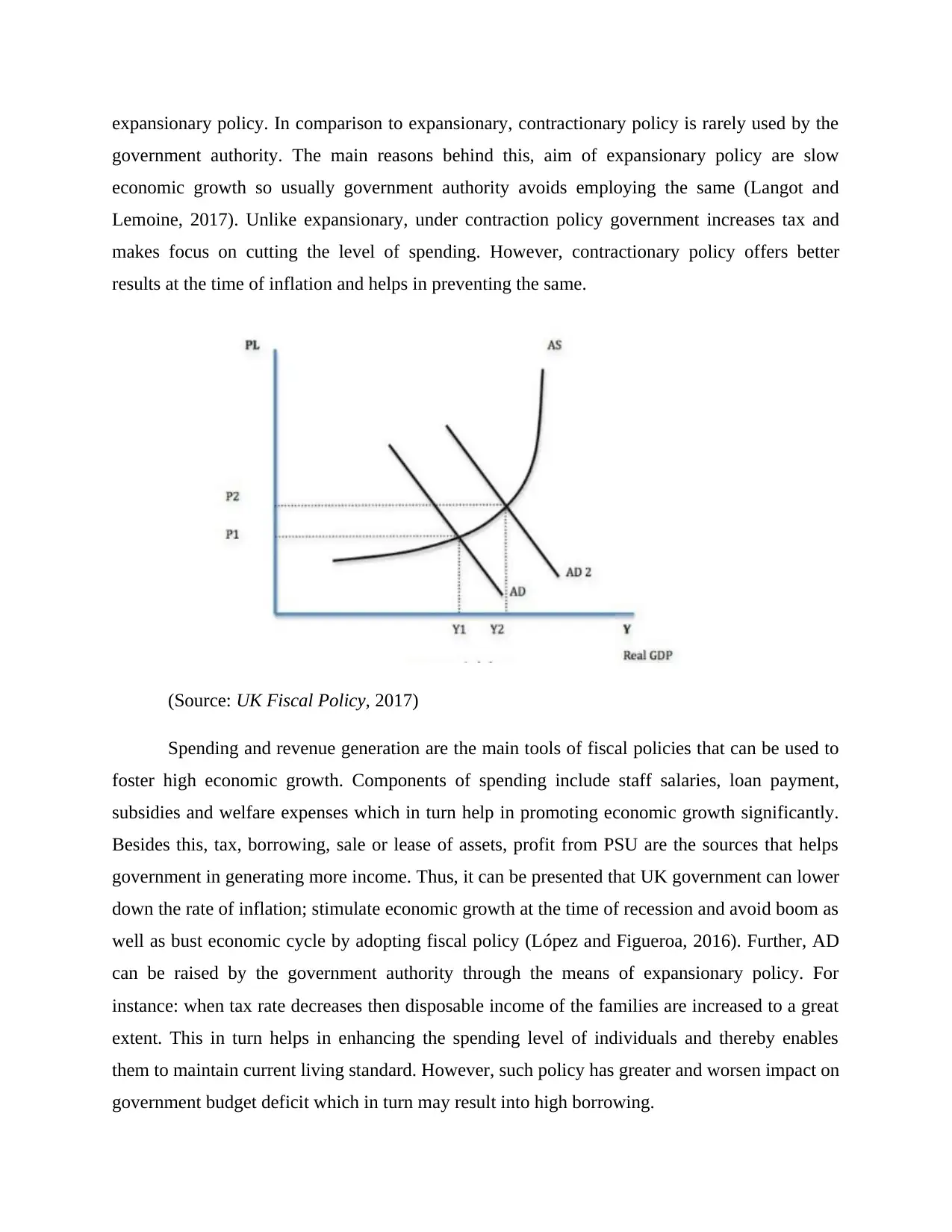
expansionary policy. In comparison to expansionary, contractionary policy is rarely used by the
government authority. The main reasons behind this, aim of expansionary policy are slow
economic growth so usually government authority avoids employing the same (Langot and
Lemoine, 2017). Unlike expansionary, under contraction policy government increases tax and
makes focus on cutting the level of spending. However, contractionary policy offers better
results at the time of inflation and helps in preventing the same.
(Source: UK Fiscal Policy, 2017)
Spending and revenue generation are the main tools of fiscal policies that can be used to
foster high economic growth. Components of spending include staff salaries, loan payment,
subsidies and welfare expenses which in turn help in promoting economic growth significantly.
Besides this, tax, borrowing, sale or lease of assets, profit from PSU are the sources that helps
government in generating more income. Thus, it can be presented that UK government can lower
down the rate of inflation; stimulate economic growth at the time of recession and avoid boom as
well as bust economic cycle by adopting fiscal policy (López and Figueroa, 2016). Further, AD
can be raised by the government authority through the means of expansionary policy. For
instance: when tax rate decreases then disposable income of the families are increased to a great
extent. This in turn helps in enhancing the spending level of individuals and thereby enables
them to maintain current living standard. However, such policy has greater and worsen impact on
government budget deficit which in turn may result into high borrowing.
government authority. The main reasons behind this, aim of expansionary policy are slow
economic growth so usually government authority avoids employing the same (Langot and
Lemoine, 2017). Unlike expansionary, under contraction policy government increases tax and
makes focus on cutting the level of spending. However, contractionary policy offers better
results at the time of inflation and helps in preventing the same.
(Source: UK Fiscal Policy, 2017)
Spending and revenue generation are the main tools of fiscal policies that can be used to
foster high economic growth. Components of spending include staff salaries, loan payment,
subsidies and welfare expenses which in turn help in promoting economic growth significantly.
Besides this, tax, borrowing, sale or lease of assets, profit from PSU are the sources that helps
government in generating more income. Thus, it can be presented that UK government can lower
down the rate of inflation; stimulate economic growth at the time of recession and avoid boom as
well as bust economic cycle by adopting fiscal policy (López and Figueroa, 2016). Further, AD
can be raised by the government authority through the means of expansionary policy. For
instance: when tax rate decreases then disposable income of the families are increased to a great
extent. This in turn helps in enhancing the spending level of individuals and thereby enables
them to maintain current living standard. However, such policy has greater and worsen impact on
government budget deficit which in turn may result into high borrowing.
⊘ This is a preview!⊘
Do you want full access?
Subscribe today to unlock all pages.

Trusted by 1+ million students worldwide
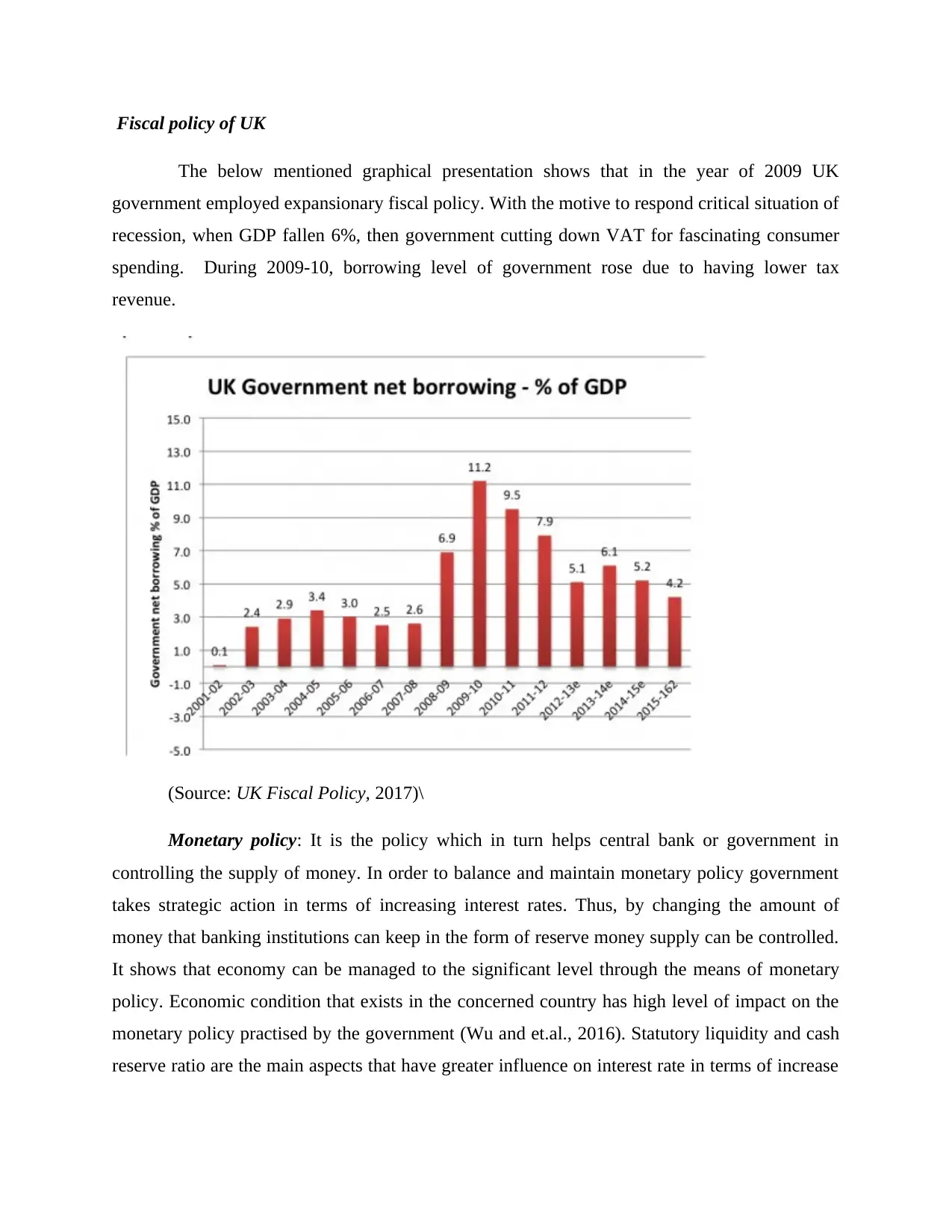
Fiscal policy of UK
The below mentioned graphical presentation shows that in the year of 2009 UK
government employed expansionary fiscal policy. With the motive to respond critical situation of
recession, when GDP fallen 6%, then government cutting down VAT for fascinating consumer
spending. During 2009-10, borrowing level of government rose due to having lower tax
revenue.
(Source: UK Fiscal Policy, 2017)\
Monetary policy: It is the policy which in turn helps central bank or government in
controlling the supply of money. In order to balance and maintain monetary policy government
takes strategic action in terms of increasing interest rates. Thus, by changing the amount of
money that banking institutions can keep in the form of reserve money supply can be controlled.
It shows that economy can be managed to the significant level through the means of monetary
policy. Economic condition that exists in the concerned country has high level of impact on the
monetary policy practised by the government (Wu and et.al., 2016). Statutory liquidity and cash
reserve ratio are the main aspects that have greater influence on interest rate in terms of increase
The below mentioned graphical presentation shows that in the year of 2009 UK
government employed expansionary fiscal policy. With the motive to respond critical situation of
recession, when GDP fallen 6%, then government cutting down VAT for fascinating consumer
spending. During 2009-10, borrowing level of government rose due to having lower tax
revenue.
(Source: UK Fiscal Policy, 2017)\
Monetary policy: It is the policy which in turn helps central bank or government in
controlling the supply of money. In order to balance and maintain monetary policy government
takes strategic action in terms of increasing interest rates. Thus, by changing the amount of
money that banking institutions can keep in the form of reserve money supply can be controlled.
It shows that economy can be managed to the significant level through the means of monetary
policy. Economic condition that exists in the concerned country has high level of impact on the
monetary policy practised by the government (Wu and et.al., 2016). Statutory liquidity and cash
reserve ratio are the main aspects that have greater influence on interest rate in terms of increase
Paraphrase This Document
Need a fresh take? Get an instant paraphrase of this document with our AI Paraphraser
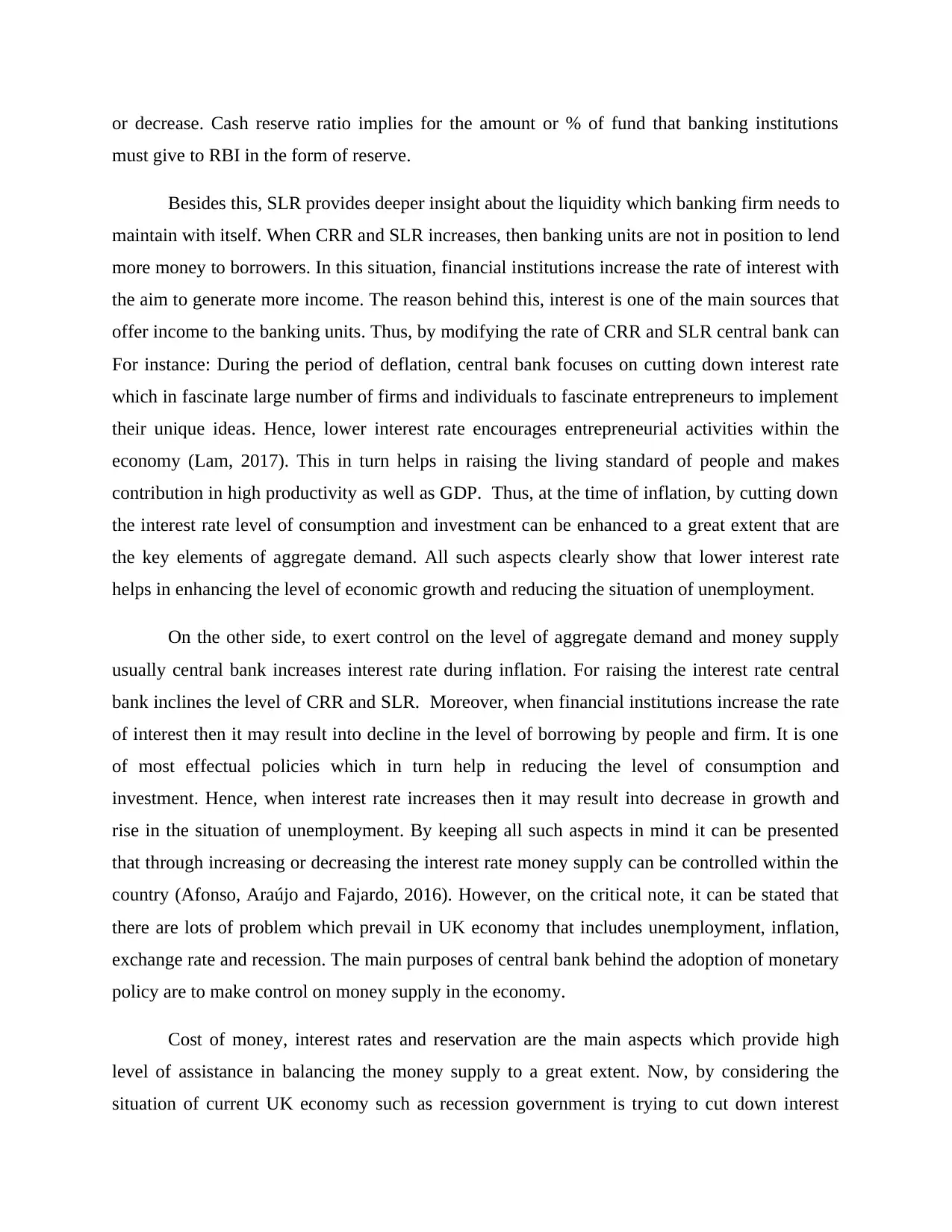
or decrease. Cash reserve ratio implies for the amount or % of fund that banking institutions
must give to RBI in the form of reserve.
Besides this, SLR provides deeper insight about the liquidity which banking firm needs to
maintain with itself. When CRR and SLR increases, then banking units are not in position to lend
more money to borrowers. In this situation, financial institutions increase the rate of interest with
the aim to generate more income. The reason behind this, interest is one of the main sources that
offer income to the banking units. Thus, by modifying the rate of CRR and SLR central bank can
For instance: During the period of deflation, central bank focuses on cutting down interest rate
which in fascinate large number of firms and individuals to fascinate entrepreneurs to implement
their unique ideas. Hence, lower interest rate encourages entrepreneurial activities within the
economy (Lam, 2017). This in turn helps in raising the living standard of people and makes
contribution in high productivity as well as GDP. Thus, at the time of inflation, by cutting down
the interest rate level of consumption and investment can be enhanced to a great extent that are
the key elements of aggregate demand. All such aspects clearly show that lower interest rate
helps in enhancing the level of economic growth and reducing the situation of unemployment.
On the other side, to exert control on the level of aggregate demand and money supply
usually central bank increases interest rate during inflation. For raising the interest rate central
bank inclines the level of CRR and SLR. Moreover, when financial institutions increase the rate
of interest then it may result into decline in the level of borrowing by people and firm. It is one
of most effectual policies which in turn help in reducing the level of consumption and
investment. Hence, when interest rate increases then it may result into decrease in growth and
rise in the situation of unemployment. By keeping all such aspects in mind it can be presented
that through increasing or decreasing the interest rate money supply can be controlled within the
country (Afonso, Araújo and Fajardo, 2016). However, on the critical note, it can be stated that
there are lots of problem which prevail in UK economy that includes unemployment, inflation,
exchange rate and recession. The main purposes of central bank behind the adoption of monetary
policy are to make control on money supply in the economy.
Cost of money, interest rates and reservation are the main aspects which provide high
level of assistance in balancing the money supply to a great extent. Now, by considering the
situation of current UK economy such as recession government is trying to cut down interest
must give to RBI in the form of reserve.
Besides this, SLR provides deeper insight about the liquidity which banking firm needs to
maintain with itself. When CRR and SLR increases, then banking units are not in position to lend
more money to borrowers. In this situation, financial institutions increase the rate of interest with
the aim to generate more income. The reason behind this, interest is one of the main sources that
offer income to the banking units. Thus, by modifying the rate of CRR and SLR central bank can
For instance: During the period of deflation, central bank focuses on cutting down interest rate
which in fascinate large number of firms and individuals to fascinate entrepreneurs to implement
their unique ideas. Hence, lower interest rate encourages entrepreneurial activities within the
economy (Lam, 2017). This in turn helps in raising the living standard of people and makes
contribution in high productivity as well as GDP. Thus, at the time of inflation, by cutting down
the interest rate level of consumption and investment can be enhanced to a great extent that are
the key elements of aggregate demand. All such aspects clearly show that lower interest rate
helps in enhancing the level of economic growth and reducing the situation of unemployment.
On the other side, to exert control on the level of aggregate demand and money supply
usually central bank increases interest rate during inflation. For raising the interest rate central
bank inclines the level of CRR and SLR. Moreover, when financial institutions increase the rate
of interest then it may result into decline in the level of borrowing by people and firm. It is one
of most effectual policies which in turn help in reducing the level of consumption and
investment. Hence, when interest rate increases then it may result into decrease in growth and
rise in the situation of unemployment. By keeping all such aspects in mind it can be presented
that through increasing or decreasing the interest rate money supply can be controlled within the
country (Afonso, Araújo and Fajardo, 2016). However, on the critical note, it can be stated that
there are lots of problem which prevail in UK economy that includes unemployment, inflation,
exchange rate and recession. The main purposes of central bank behind the adoption of monetary
policy are to make control on money supply in the economy.
Cost of money, interest rates and reservation are the main aspects which provide high
level of assistance in balancing the money supply to a great extent. Now, by considering the
situation of current UK economy such as recession government is trying to cut down interest
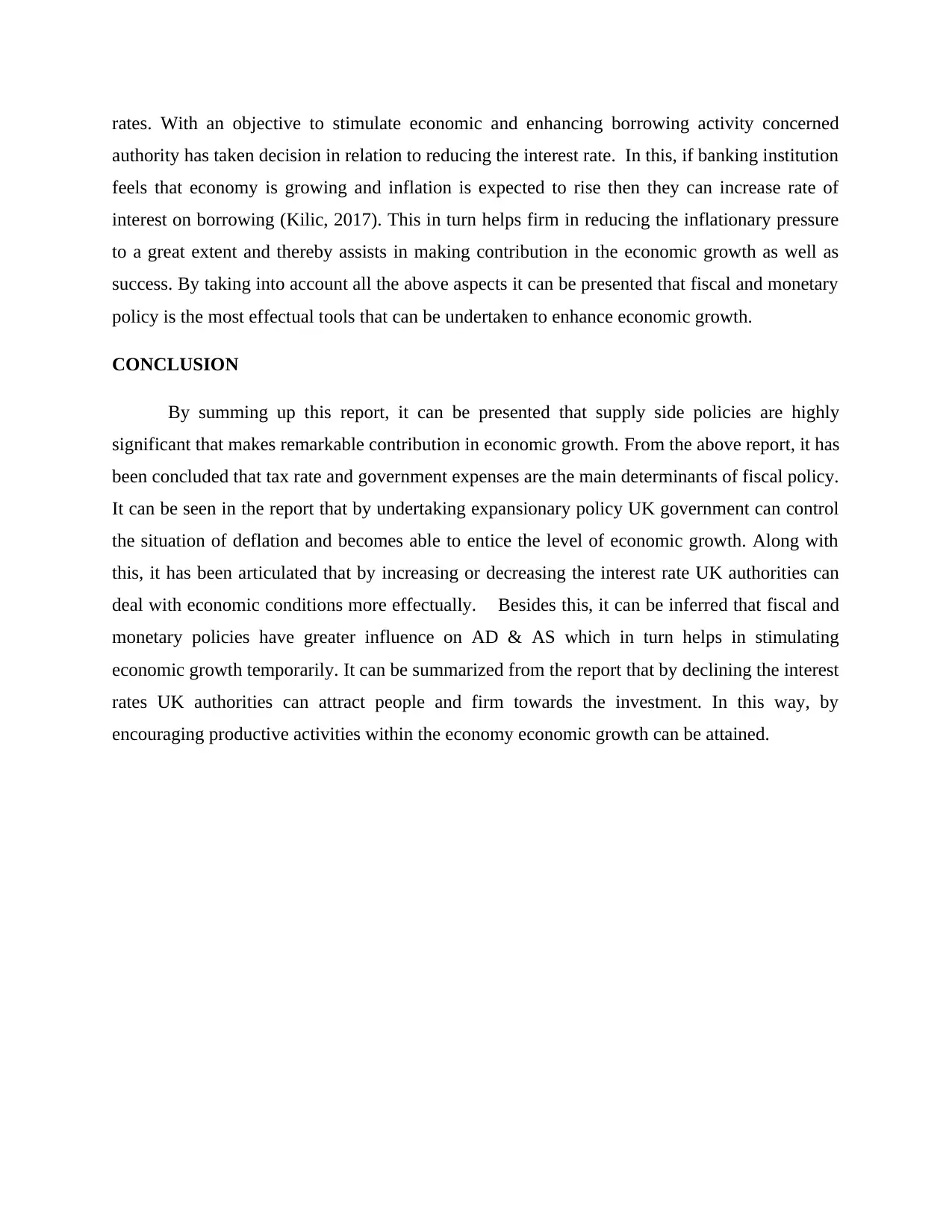
rates. With an objective to stimulate economic and enhancing borrowing activity concerned
authority has taken decision in relation to reducing the interest rate. In this, if banking institution
feels that economy is growing and inflation is expected to rise then they can increase rate of
interest on borrowing (Kilic, 2017). This in turn helps firm in reducing the inflationary pressure
to a great extent and thereby assists in making contribution in the economic growth as well as
success. By taking into account all the above aspects it can be presented that fiscal and monetary
policy is the most effectual tools that can be undertaken to enhance economic growth.
CONCLUSION
By summing up this report, it can be presented that supply side policies are highly
significant that makes remarkable contribution in economic growth. From the above report, it has
been concluded that tax rate and government expenses are the main determinants of fiscal policy.
It can be seen in the report that by undertaking expansionary policy UK government can control
the situation of deflation and becomes able to entice the level of economic growth. Along with
this, it has been articulated that by increasing or decreasing the interest rate UK authorities can
deal with economic conditions more effectually. Besides this, it can be inferred that fiscal and
monetary policies have greater influence on AD & AS which in turn helps in stimulating
economic growth temporarily. It can be summarized from the report that by declining the interest
rates UK authorities can attract people and firm towards the investment. In this way, by
encouraging productive activities within the economy economic growth can be attained.
authority has taken decision in relation to reducing the interest rate. In this, if banking institution
feels that economy is growing and inflation is expected to rise then they can increase rate of
interest on borrowing (Kilic, 2017). This in turn helps firm in reducing the inflationary pressure
to a great extent and thereby assists in making contribution in the economic growth as well as
success. By taking into account all the above aspects it can be presented that fiscal and monetary
policy is the most effectual tools that can be undertaken to enhance economic growth.
CONCLUSION
By summing up this report, it can be presented that supply side policies are highly
significant that makes remarkable contribution in economic growth. From the above report, it has
been concluded that tax rate and government expenses are the main determinants of fiscal policy.
It can be seen in the report that by undertaking expansionary policy UK government can control
the situation of deflation and becomes able to entice the level of economic growth. Along with
this, it has been articulated that by increasing or decreasing the interest rate UK authorities can
deal with economic conditions more effectually. Besides this, it can be inferred that fiscal and
monetary policies have greater influence on AD & AS which in turn helps in stimulating
economic growth temporarily. It can be summarized from the report that by declining the interest
rates UK authorities can attract people and firm towards the investment. In this way, by
encouraging productive activities within the economy economic growth can be attained.
⊘ This is a preview!⊘
Do you want full access?
Subscribe today to unlock all pages.

Trusted by 1+ million students worldwide
1 out of 15
Related Documents
Your All-in-One AI-Powered Toolkit for Academic Success.
+13062052269
info@desklib.com
Available 24*7 on WhatsApp / Email
![[object Object]](/_next/static/media/star-bottom.7253800d.svg)
Unlock your academic potential
Copyright © 2020–2025 A2Z Services. All Rights Reserved. Developed and managed by ZUCOL.




